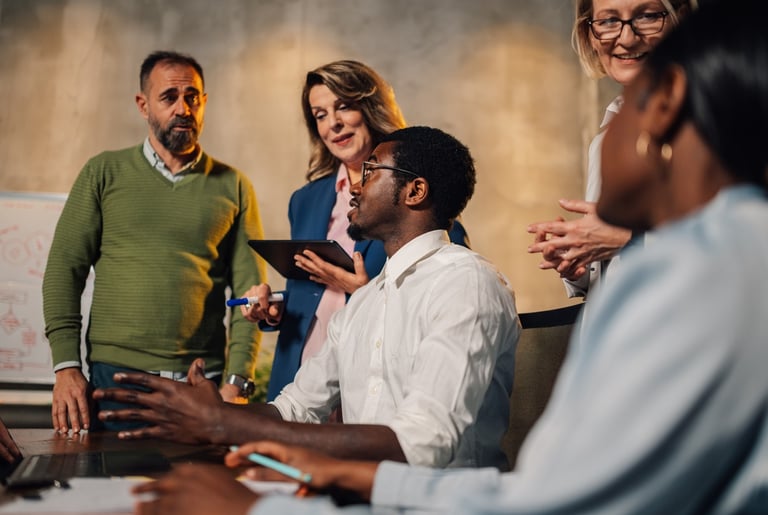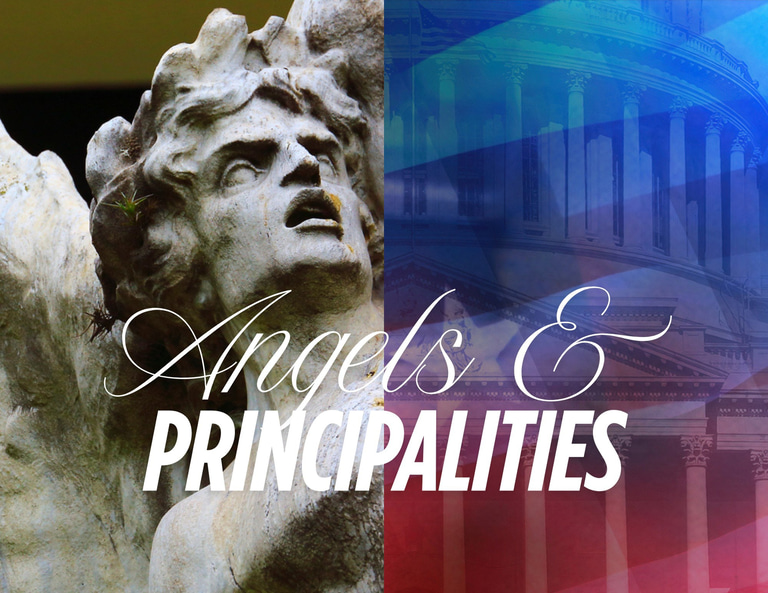Frank DuNN: Conversations at the junction of faith and politics
Building Communities of Truth
The way to have the society we want starts by building small communities embodying the qualities we want our society to manifest.
Frank Dunn
7/29/202511 min read


“What’s going to happen?” one of my kids used to ask me when she was little. I was always a bit bemused by her question, wondering where it came from. Curiosity? Anxiety? A simple need to know what to expect? These days I often find myself asking what’s going to happen.
It’s only self-defeating and soul-depleting to spend energy reacting to every egregious development, every outrage, every grandstanding bluster that comes out of the mouths of officials. Yet, as I think you know, silence and resignation to me are adding to the problem, neither dodging it nor solving it. I think instead about what’s going to happen. What do I, what do you want to happen? I can’t control what will happen, but I can affect it.
So can you.
By now, we should know that the darkness we are living in did not start with Donald Trump. He has only pulled the scab off many a wound that’s been festering for decades, some for centuries. My eight decades have been dominated by a continual buildup of the conflict between those who envision this republic as a broadening community in which every person matters versus those who think that some people are better than others. Dividing lines vary. Education, erudition, social standing, religion, income, ethnicity, color, race, language, gender, sexuality, marital status, and a long list of other categories have all served as ways to differentiate between the worthy and the unworthy.
Of course, none of this is new, and little of it is peculiarly American. Dr. James E. Laws, a friend of mine, taught for years at Virginia Commonwealth University a course called “The Structures of Racism.” He made the comment in one of his lectures that human beings always find a way to discriminate against someone different. You can, he said, put a bunch of white, blond, blue-eyed people in a room and leave them for a while, and before long they’ll have found some characteristic that will be the basis on which they’ll rank people: length of nose, shape of eyes, quantity of hair, straightness of teeth, or something else.
I’m not holding my breath until we scrub from human beings our collective propensity to rank and discriminate. But neither am I willing simply to forfeit the game by sighing “that’s all there is and all there ever will be.”
Which brings me to the place of seeing that the question before us is not who is going to win the most votes in the next election. Nor is my focus how we can patch up the now smashed structures of a government that at least was serving the needs of a great many people long left out of the successive waves of prosperity lucky Americans have enjoyed.
The issue is what kind of community do we want to have.
That, in my view, is what the struggle really is about. Project 2025[1] leaves no doubt about the vision its owners and operators are now working assiduously to implement. That vision is not an interpretation of American democracy. It is a vision of a theocratic autocracy. As such, it is not a vision that is at all compatible with the Constitution. Is it radically opposed to the republic established by the Constitution. That is why all the “guardrails” and “safeguards” built into the Constitution, such as the separation of powers with checks and balances, are now themselves enervated at the highest levels. You can’t firmly establish a theocratic autocracy playing by democratic rules.
Dr. Charles R. Lawrence III, Professor at the Manoa School of Law at the University of Hawaii, and a constitutional authority, has asserted that the Constitution was not simply a document founding a government, but was the instrument for creating a community. “We the People of the United States in order to form ...” is the clue that validates Dr. Lawrence’s point: the people are the ones who form community; the Constitution is the means by which they do it.
I submit that the workability of the Constitution or any constitution, lies in direct proportion to a government’s ability to provide for the health, wellbeing, sustenance, and protection of the community for which it is the foundational governing instrument.
What kind of community would it take to protect, safeguard, and proclaim truth?
Right off the bat, I know that it will take communities, not a community. That’s reality. The fantasy that we can all come together and be one happy family never has nor ever will fit a society which can never be other than diverse. How do I know that? By examining the statistics.
The United States is becoming increasingly diverse, with significant shifts in its racial and ethnic composition. The "non-white" population is growing at a faster rate than the white population, leading to a projected demographic turning point in the coming decades. The United States is projected to become a "majority-minority" country in the not-so-distant future. The combined racial and ethnic minority populations will make up more than 50% of the total population, and the non-Hispanic white population will be less than half around 2045, according to the Census Bureau. In that year, the non-Hispanic white population is projected to be around 49.7% of the total population.
Already younger age groups are indicating the trend. As of 2020, minorities already outnumbered whites in the population of children under 18. This trend is expected to continue, with the non-Hispanic white population comprising only about 36% of the under-18 population by 2060.
Furthermore, the Pew Research Center indicates that, if current trends continue, the Christian majority in the United States will likely end by 2070, at which time that majority is projected to fall to 46%. Over the same period, the religiously unaffiliated population is projected to rise to between 34% and 52%, potentially becoming the largest single group.
The decline of the Christian population is driven significantly by the sharp decrease in the number of white Christians. The percentage of Americans who identify as white Christians has been steadily decreasing for decades. In 1990, they made up about 72% of the population, but that number had fallen to roughly 40% by 2024. This decline is most pronounced among younger generations. Young adults (ages 18-29) are significantly less likely to identify as Christian than older generations. Several factors contribute to the decline, including the fact that many people, particularly young adults, leave the religion they were raised in. The fastest-growing segment of the population, "Christians of color," has not so far been able to fully offset the decline of the white Christian population.[2]
If we’re smart, we’ll begin by recognizing we have some serious homework to do in re-thinking what “community” means, how communities are formed, and what sustains them. I confess that octogenarian white males such as I can’t say much that is compelling to such a diverse population. Yet, I can say some things I know about communities in general.
All human beings need essentially the same things to survive and thrive. Adequate food, potable water, clean air, safety including protection from the elements including natural disasters, affordable health care are all items on the essentials list. In the present world, some additional things have moved from options to essentials. Autonomy is one. Adequate time for rest and restoration of body, mind, and spirit are not optional for thriving if for survival. I would add communication to the list, as we now are so interconnected all over the planet that virtually none can live in isolation.
All this presupposes adequate means to afford all the necessities. With wealth increasingly concentrated in the hands of a very small percentage of the world’s population, millions lack the financial resources to sustain their sheer existence.
What’s hard about understanding this?
To my mind, there is a link between all those statistical realities above and the resistance to acknowledge humanity’s basic needs. It appears likely that the authors of Project 2025 had the above statistics in mind as they drew the plans for the current administration, now implementing Project 2025. It seems to me that those who are, or wish to be, in power are running scared. Frankly, I would be scared too if I were looking to preserve and extend white supremacy and saw all these figures telling me that my power was on the brink of extinction (or at least being neutered) by all those others unless extreme measures were taken to sustain it.
When I first heard the chants of rightwing protestors in Charlottesville in 2017, I thought it odd that one of their chants was “Jews will not replace us.” Of course, that’s easy to understand out of the throats of neo-Nazis. But the entire “grand replacement theory” is nothing to sneeze at.[3] Whether or not white people’s fears, especially those of Christian white people fearing becoming a minority, motivated parts of Project 2025, it is difficult to erase the handwriting on the wall: we will become a majority-minority nation, and that transition will not necessarily be favorable to the current majority.
If I am anywhere near correct that the current political regime is steadily creating a government that has aims other than addressing the needs of ordinary citizens, including the powerless, defenseless, and most vulnerable, then the best response I’m able to imagine is a conscious effort to create, strengthen, support, and sustain communities of individuals who can talk about the truths of their lives. For that is how people experience truth: not as an abstract concept or remote standard, but as the realities showing up in their experience.
The most positive thing I see happening right now is that people are coming together online, in person, in the streets, in synagogues, mosques, churches, homes, and in small affinity groups discussing how they can take responsibility for democracy. For that development, I am grateful for the current situation, if only for that. Only when people are threatened and angry do they tend to respond to attacks on their liberty or demand release from repression and degradation. Popular uprisings are risky, accompanied by no guarantee of turning out well. But systemic change by its nature can’t be imposed from above.
One of the unexpected outcomes of the pandemic was a burgeoning of people meeting online. Although that understandably waned with the weakening of its cause—the pandemic, people all over the world now have experienced coming together in virtual communities. Add to that the need for people to form in-person relationships, and the prospect of forming networks of small communities working for transformation becomes a present reality. Building communities of truth will likely continue to happen organically, arising from the grassroots, from ordinary people. We tend to do best, in my experience, when we connect with people whom we know or can come to know, trust, and relate to positively.
I don’t mean to suggest that such communities can’t be diverse. In fact, I think it would be tragic for communities not to deliberately build bridges beginning by being diverse themselves. The guiding principle, I believe, is building communities that are small models of the great community called humankind that we wish to belong to.
There certainly are ways of being programmatic while at the same time not laying on procedures or protocols that must be slavishly followed. I am thinking of the hosts of people who have great experience in community organizing as well as those who have begun churches, clubs, and other organizations. Looking to past practices can be good in spotting effective approaches in building communities. Yet, I think the real leadership for these kinds of communities to flourish will be young, fresh, open, competent folks. What about people like me or many readers of this blog who are not young and fresh but possibly open? I’d consider it an honor to mentor young folks, keeping my mouth shut as much as possible except to ask questions and listen to responses.
I invite you to have conversations with others who are willing to dream. Consider being a catalyst who starts by connecting with those in your orbit: friends, family members, co-workers, fellow church or synagogue members, people you sing with in community choruses, folks who share your enthusiasm for theatre, your tennis partners or golf buddies. Even those who live in isolated places have phones and computers. Don’t wait for somebody else to start a conversation. If you can’t organize a small community yourself, how about talking someone else into doing so? No conversation is lost, even if the results are less than you hoped for.
Use this blog and other such venues to share resources, spread the word, focus on issues. Our species has evolved by adapting and surviving threats. I can think of nothing more crucial than giving all we’ve got to build communities exploring, understanding, defending, and spreading Truth.
How else can we and succeeding generations survive?
[1] See https://en.wikipedia.org/wiki/Project_2025, accessed July 27, 2025. Note the Project’s aim of ending diversity, equity, and inclusion (DEI) programs[5][26] while having the DOJ prosecute anti-white racism instead.[27] The project recommends the arrest, detention, and mass deportation of illegal immigrants.[28][29]
[2] I have distilled statistical data from AI generated answers to my questions about the state and rate of population changes relative to social, cultural, and ethnic factors with projections covering the balance of the 21st century.
[3] See https://en.wikipedia.org/wiki/Great_Replacement_conspiracy_theory for how this relatively recent iteration of a very old type of fear has led to now debunked conspiracy theories still subscribed to by right-wing elements who hold that “replacement elites” are destroying predominantly white cultures.
A Community Model for Truth Seekers
During the pandemic, Stephen Silha, a friend of mine and a subscriber to this blog, invited me to attend an online Village meeting.
It is exactly the kind of thing I believe is a viable answer to the question of how we might go about creating spaces where people can come together—in person, online, or both—to connect, to find support, to share ideas, to cross lines that frequently separate us, including the reality of geographical availability. It’s a space where people can share their truths.
Have a look at this website. Think about how you might use this, or adapt it, as a means of forming a space where you can get together with others. Here’s what Stephen says:
Among many organizations working to bring people together is VillageCo, an Idaho-based non-profit trying to change CO(rporation) to CO(mmunity). I began attending the weekly meetings on Zoom during the height of Covid in fall, 2020~and found a new community of friends, builders of trust, and co-creators.
The format is simple:
• there’s a grounding to invite everyone into the creative space
• several random one-on-one breakouts [community connections] with a helpful prompt
• acknowledgment by a member of the community about something they care about
• the rest of the time is spent with Open Space discussions on any topic or question someone proposes. It works the same in person. And it works.
The connections and discussions were so useful and inspiring to me that I have started a Village in my family, and also one in my condominium. We all found the structure allows us to connect on a deeper level, to listen better, and to relate to people different or distant from us (including younger family members).
We also experimented with the Village format to help create and promote a new nonprofit – The Adolescent Redemption Project (TARP). The TARP Village was most useful, as it provided a rare opportunity for dialogue among incarcerated men and women, juvenile justice organizers, parents, lawyers, friends and loved ones of those inside, as well as returning citizens.
Here is the link to Village:
https://meetvillage.villageco.org/
Click on that and you’ll find a description of what Village is and a toolbox of the simple things you need to know if you want to start one.
Stephen Silha is a freelance writer, filmmaker, facilitator, and futurist. A former reporter for The Christian Science Monitor and The Minneapolis Star, he is past president of AIDS Housing of Washington, which built the first hospice in the U.S. specifically for people with AIDS. His first feature film, which he produced and co-directed, BIG JOY: The Adventures of James Broughton, about one of his mentors, has traveled to 50+ festivals and won several awards. He lives in Takoma, Washington.


